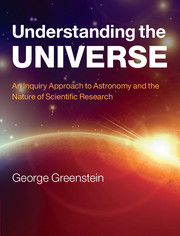Book contents
- Frontmatter
- Contents
- Preface
- Acknowledgments
- Part I Introducing steps to astronomy
- Part II The Solar System
- Part III Introducing stars
- 11 Our Sun
- 12 A census of stars
- 13 The formation of stars and planets
- 14 Stellar structure
- 15 Stellar evolution and death
- Part IV Introducing galaxies and the Universe
- Epilog
- Appendix I The small-angle formula
- Appendix II Exponential notation
- Appendix III The Solar System
- Appendix IV The closest and brightest stars
- Appendix V Physical and astronomical constants
- Appendix VI Conversion factors
- Appendix VII Constellation maps
- Glossary
- Figure Credits
- Index
- Plate section
13 - The formation of stars and planets
from Part III - Introducing stars
Published online by Cambridge University Press: 05 February 2013
- Frontmatter
- Contents
- Preface
- Acknowledgments
- Part I Introducing steps to astronomy
- Part II The Solar System
- Part III Introducing stars
- 11 Our Sun
- 12 A census of stars
- 13 The formation of stars and planets
- 14 Stellar structure
- 15 Stellar evolution and death
- Part IV Introducing galaxies and the Universe
- Epilog
- Appendix I The small-angle formula
- Appendix II Exponential notation
- Appendix III The Solar System
- Appendix IV The closest and brightest stars
- Appendix V Physical and astronomical constants
- Appendix VI Conversion factors
- Appendix VII Constellation maps
- Glossary
- Figure Credits
- Index
- Plate section
Summary
Before turning to a study of the structure of the Sun and other stars, we discuss how they were formed. As we will see, the processes that form stars also form planets orbiting about them. So we are really discussing the origin of the Solar System as a whole.
Before the advent of modern science, such a study was really the province of myths and religion: ancient peoples made up stories about the creation of the world. It is important to emphasize that these stories had no basis in the kind of observation and deduction that forms the essential basis of scientific reasoning. Not so very long ago, however, the situation changed.
It changed for a variety of reasons. In the first place, the studies we have described of the structure of the Solar System showed that our Earth is but one among a whole panoply of moons, asteroids and planets – and that the configuration of this vast system gives us clues as to its origin. In the second place, the development of modern physics gives us the tools to reach an understanding of this origin. And in the third place, recently we have been able to actually observe other stars and planetary systems in the midst of their formation. These observations have added new and totally unexpected elements to our understanding.
Most importantly of all, though, is that our thinking about the origin of the world has totally changed. No longer does this origin lie in the realm of the magical or the supernatural. Now it is an empirical matter, one that we can study with the tools of science, and one that we are capable of understanding.
- Type
- Chapter
- Information
- Understanding the UniverseAn Inquiry Approach to Astronomy and the Nature of Scientific Research, pp. 368 - 394Publisher: Cambridge University PressPrint publication year: 2013



